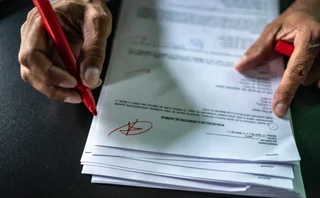

Allianz’s solvency ratio dips 11 points
Share buyback, market moves, regulatory tweaks all take their toll on capital
German insurance group Allianz saw its Solvency II regulatory ratio dip to 218% at end-March, from 229% three months prior, as the firm returned cash to shareholders and factored in the capital-sapping effects of lower interest rates.
The insurer’s own-funds, the numerator for the Solvency II ratio, increased to €78.6 billion ($88 billion) from €76.8 billion (2%) at end-2018, and from €75.4 billion in the year-ago quarter. But its solvency capital requirement (SCR), the ratio’s denominator
Only users who have a paid subscription or are part of a corporate subscription are able to print or copy content.
To access these options, along with all other subscription benefits, please contact info@risk.net or view our subscription options here: http://subscriptions.risk.net/subscribe
You are currently unable to print this content. Please contact info@risk.net to find out more.
You are currently unable to copy this content. Please contact info@risk.net to find out more.
Copyright Infopro Digital Limited. All rights reserved.
As outlined in our terms and conditions, https://www.infopro-digital.com/terms-and-conditions/subscriptions/ (point 2.4), printing is limited to a single copy.
If you would like to purchase additional rights please email info@risk.net
Copyright Infopro Digital Limited. All rights reserved.
You may share this content using our article tools. As outlined in our terms and conditions, https://www.infopro-digital.com/terms-and-conditions/subscriptions/ (clause 2.4), an Authorised User may only make one copy of the materials for their own personal use. You must also comply with the restrictions in clause 2.5.
If you would like to purchase additional rights please email info@risk.net
More on Risk Quantum
G-Sib cross-border risk drops to four-year low
Two-thirds of systemic banks saw systemic indicator decrease in 2023
Thirteen EU banks face loan losses of more than 16% from green switch
Climate stress test predicts overall bank losses of 6%, rising to 11% under adverse scenarios
Deutsche misses G-Sib surcharge cut despite EU score benefit
Carve-out of intra-bloc exposure lowers score below 230bp, but 1.5% surcharge remains
Post-UBS takeover, Switzerland sees biggest regional G-Sib score spike
Credit Suisse acquisition pushes UBS’s complexity category to all-time high, driving up country’s overall score
Deutsche’s IRC tops €8 billion in four-year high
Ballooning credit-event risk charge contrasts with Q3 drop at BNP Paribas, ING
Fed’s stricter G-Sib scoring punishes BofA, Goldman
Duo’s method 2 capital requirements will diverge further from those entailed by Basel’s methodology
Italian funds snatch record €24bn debt securities in September
Mixed funds’ holdings jump by half as bond-only funds tick up 2%
Options expiry triggers $4bn liquidity shortfall at NSCC
Second-largest simulated shortfall on record mitigated by extra liquidity deposit and OCC commitment







